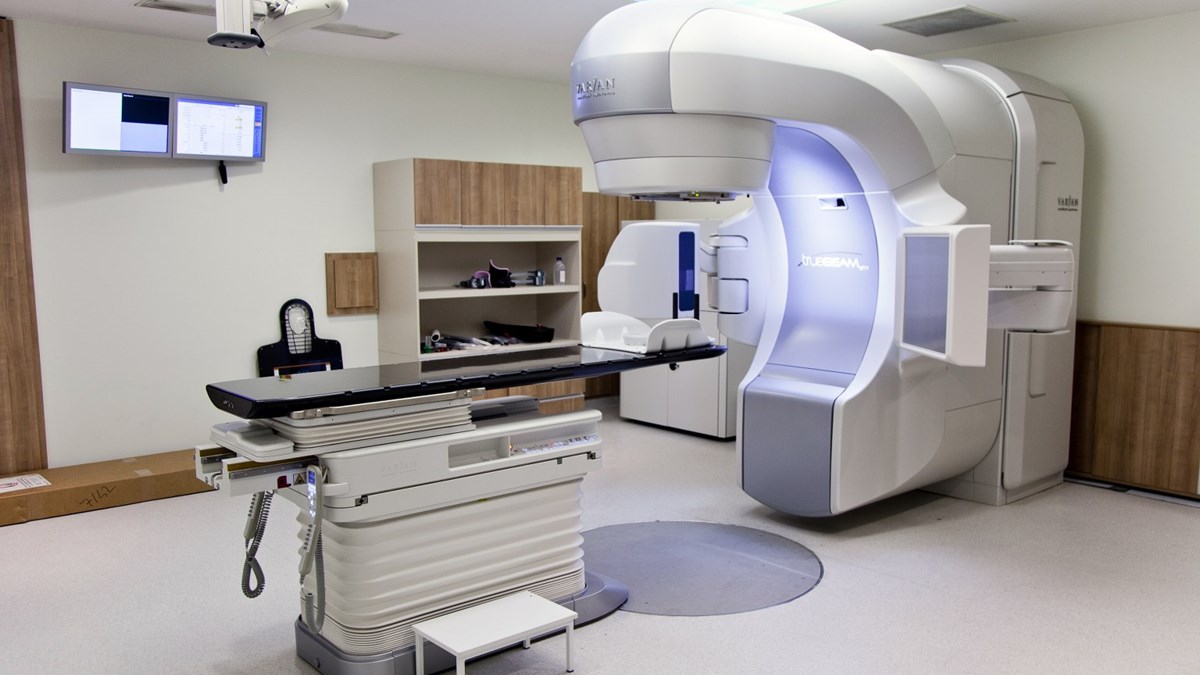Radiotherapy
Radiotherapy uses different forms of radiation to kill cancer cells. It can also affect healthy cells. Most commonly radiotherapy is delivered using photons. Other types include protons and heavy ions. Not all types are currently available on the NHS. A number of techniques are the subject of research, which could potentially be beneficial to patients with ACC and other salivary gland cancers. Treatment could potentially be available through the research institutions involved.
There are limits to the amount of radiation that can be used on a site and treatment produces side effects, some of which are temporary and some of which are permanent. You can hear more about how these side effects have affected some patients in Our stories. Further information can also be found here.
External Radiotherapy
External Radiotherapy is administered on a machine called a linear accelerator (LINAC). It moves around the patient to ensure the tumour receives a very high dose and normal healthy cells nearby receive a much lower dose so reducing the risk of long-term side effects. These treatments can also be delivered on a Tomotherapy machine.
Internal Radiotherapy or Brachytherapy
Radiation is delivered through radioactive sources that are placed in the body inside or near to the tumour. They are placed in the body using a needle or catheter.
Patient Experiences of Radiotherapy Treatment
You can hear patient experiences of radiotherapy treatment, on the our stories page. Dawn's shares her top tips for a patient undergoing radiotherapy treatment here.
Expert Advice on Living with the Late Effects of Radiotherapy Treatment
You can hear from Emma Hallam, consultant late effects radiographer on the late effects of radiotherapy here, and her tips for Salivary Gland Cancer patients living with them here.
Intensity Modulated Radiotherapy (IMRT)
Intensity Modulated Radiotherapy (IMRT)
IMRT shapes the radiation beams to closely fit the area of the cancer. For treatment in the head and neck area you will need to wear a plastic mask which prevents you from moving during the treatment sessions so the radiotherapy is delivered to the right area.
IMRT is readily available on the NHS at many centres in the UK
Proton Beam Therapy
Proton Beam therapy delivers proton beams rather than X-rays to the tumour site with very little radiation exposure to the tissues around the edge of the tumour being treated.
In the UK, two NHS centres will be providing proton beam therapy to patients. The Christie Hospital in Manchester opened their centre in Autumn 2018 and the first patient was treated in December 2018. The second NHS centre at University College London Hospitals is currently being built and is due to start treatment in 2020. When complete, the two centres will each treat up to 750 patients every year.
Further information including for treatment referral outside the UK can be found on the NHS website:
https://www.england.nhs.uk/commissioning/spec-services/highly-spec-services/pbt/
Carbon Ion Therapy (aka Heavy Ion therapy)
Carbon Ion irradiation uses charged carbon nuclei which are particularly heavy and loaded with energy. They are directed at the tumour and the biological effectiveness of these carbon ions is even greater than for protons.
In the UK, carbon ion treatment is not currently available and there is no mechanism for NHS referral outside of the UK. There are centres outside the UK that will accept and treat UK patients privately, including Heidelberg.
You can watch Dr Alex Jensen talk about 'Carbon Ion therapy: what it is, how it works & how it relates to adenoid cystic carcinoma and other salivary gland cancers' here.
Stereotactic Body Radiation Therapy (SBRT) / Stereotactic ablative radiotherapy (SABR)
SBRT or SABR gives radiotherapy to a tumour from different positions around the body. You may have small metal markers (fiducial markers) put in or near your tumour to ensure the treatment is targeted very precisely. Commonly the machine used is the LINAC but there are others including the CyberKnife.
SBRT/SABR is readily available on the NHS at many centres in the UK. More detail on SABR can be found here.
Jim has shared his experience with SABR in our stories here.
Internal Radiotherapy or Brachytherapy
Radiation is delivered through radioactive sources that are placed in the body inside or near to the tumour. They are placed in the body using a needle or catheter.
In the UK, brachytherapy is available but it is not a treatment routinely offered to Adenoid Cystic Carcinoma patients with lung metastases. To hear about one patient's experience with brachytherapy, listen to Ruth's story.
There is currently an ACCRF funded retrospective trial in the US, run by Dr Doggett who treats ACC patients with lung mets http://www.nocancer.com/. This trial is to determine the response rate of the treatment. There is no NHS referral mechanism for this treatment.

